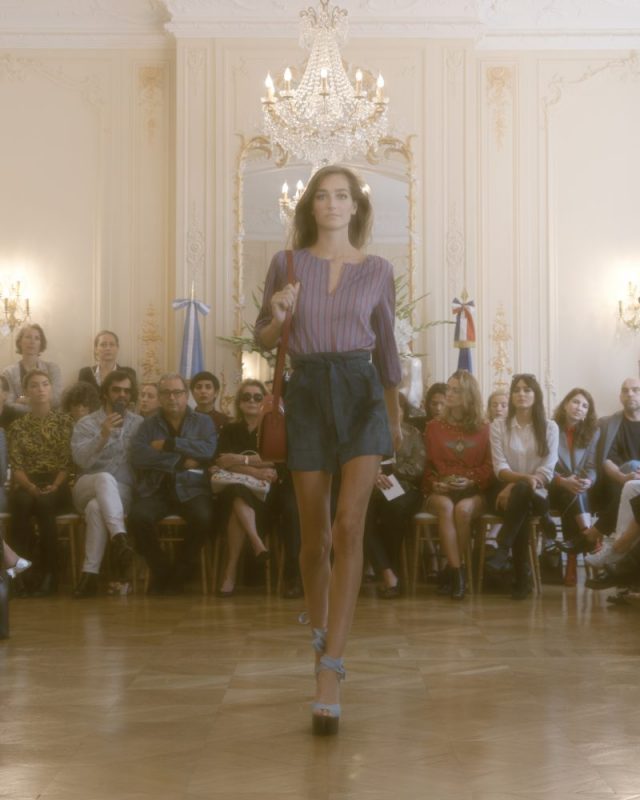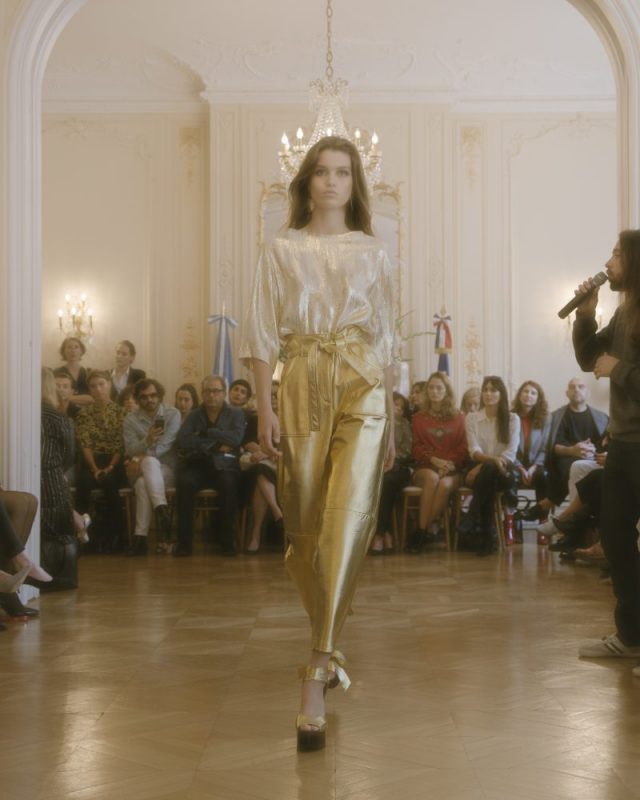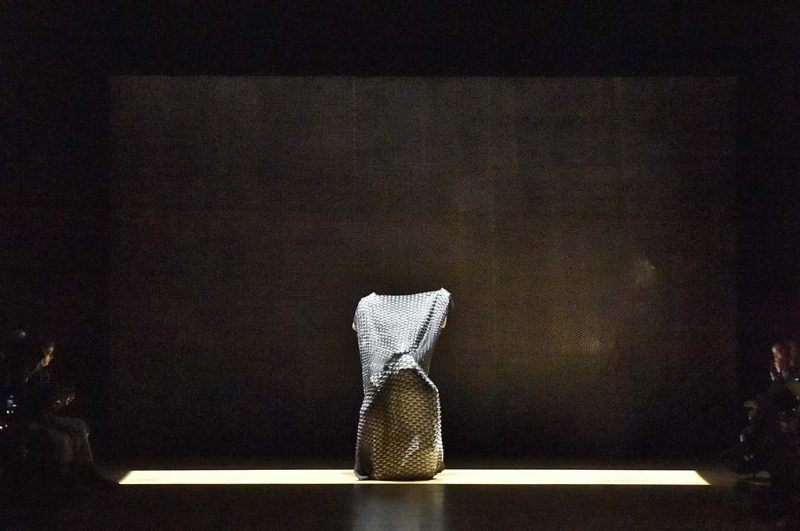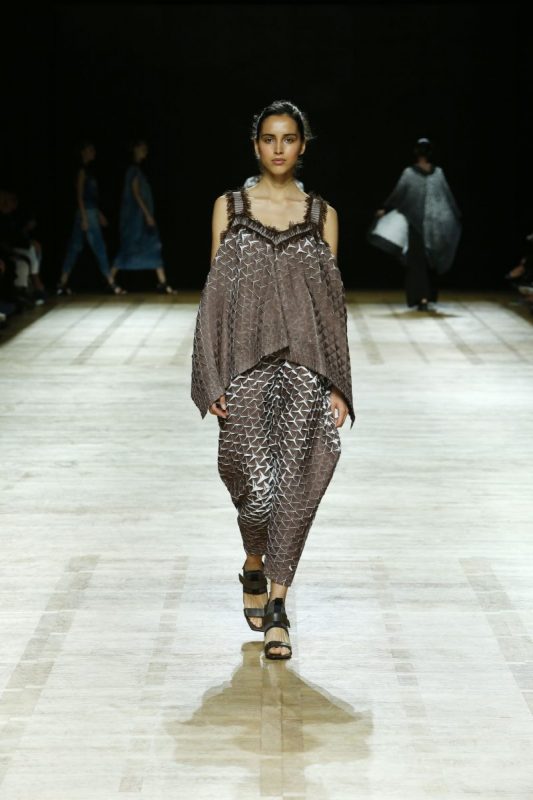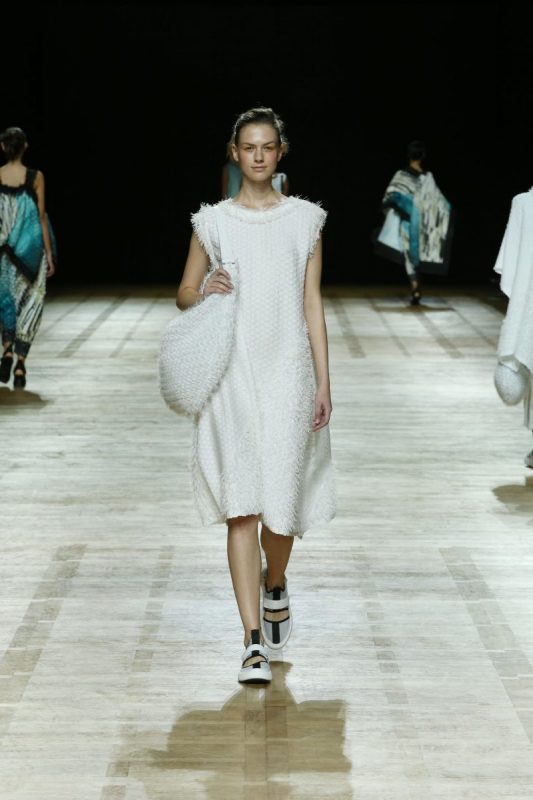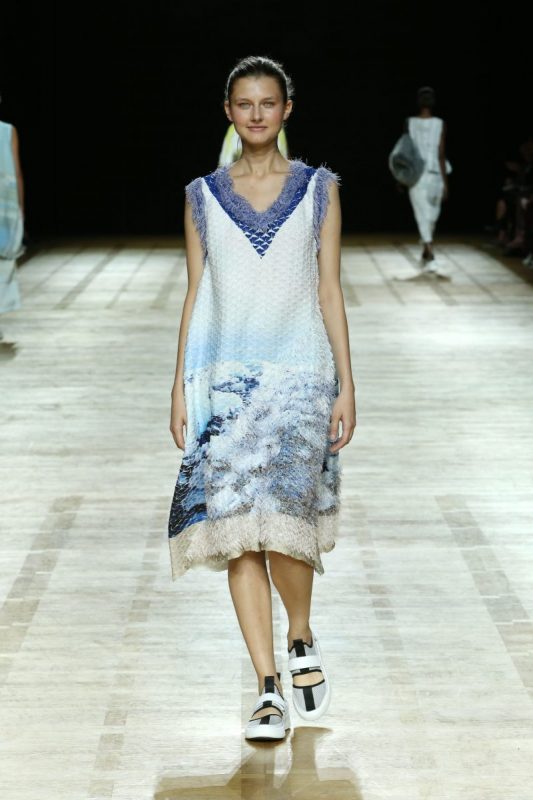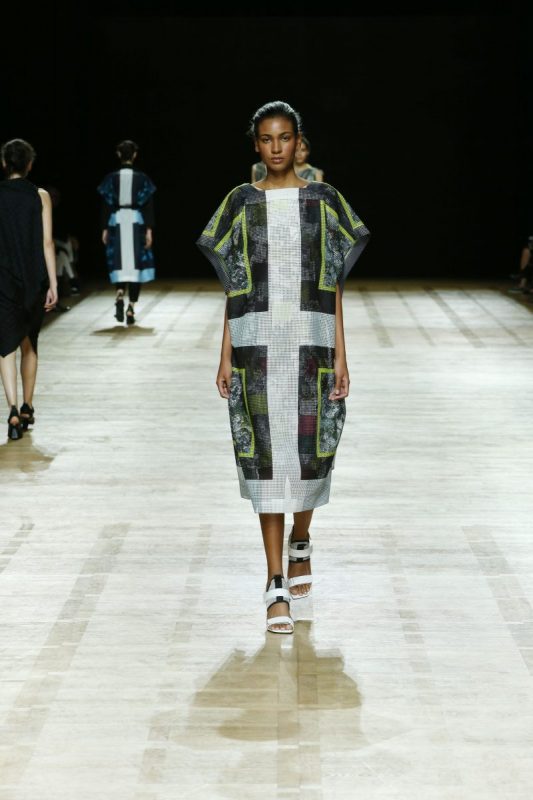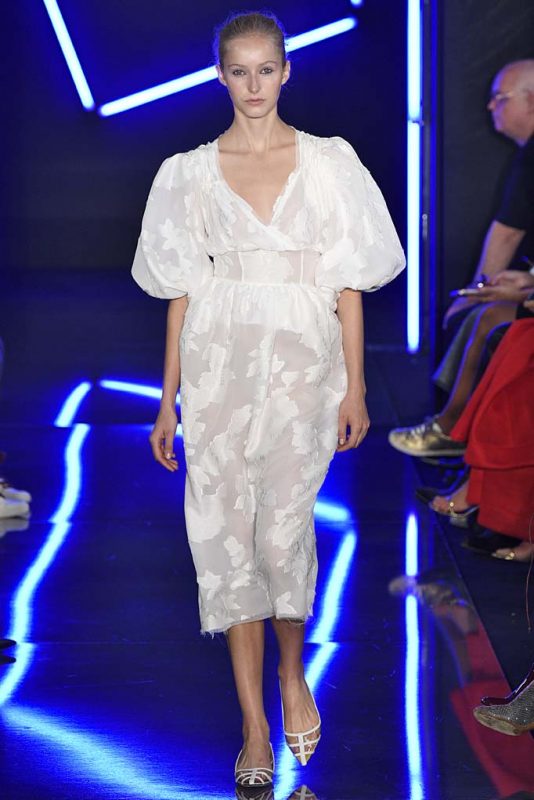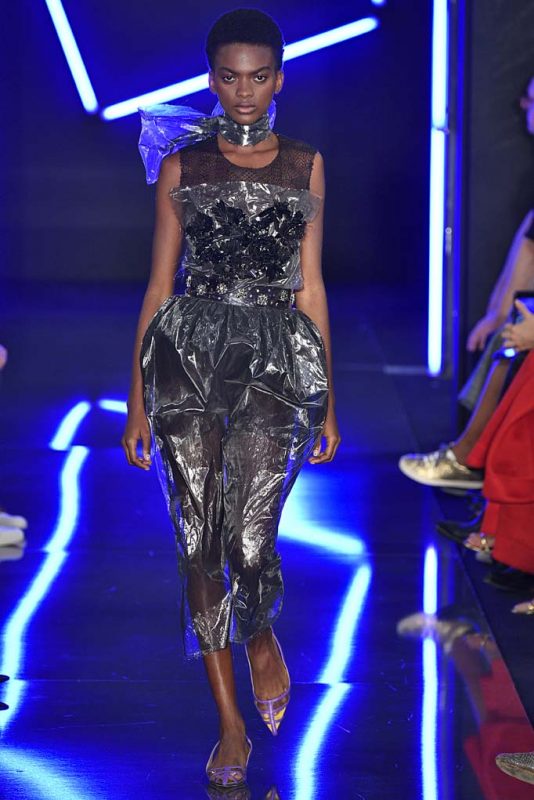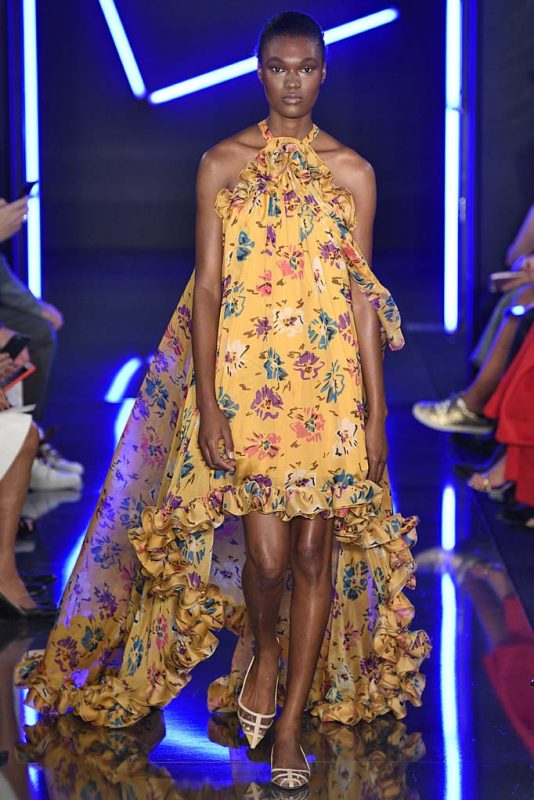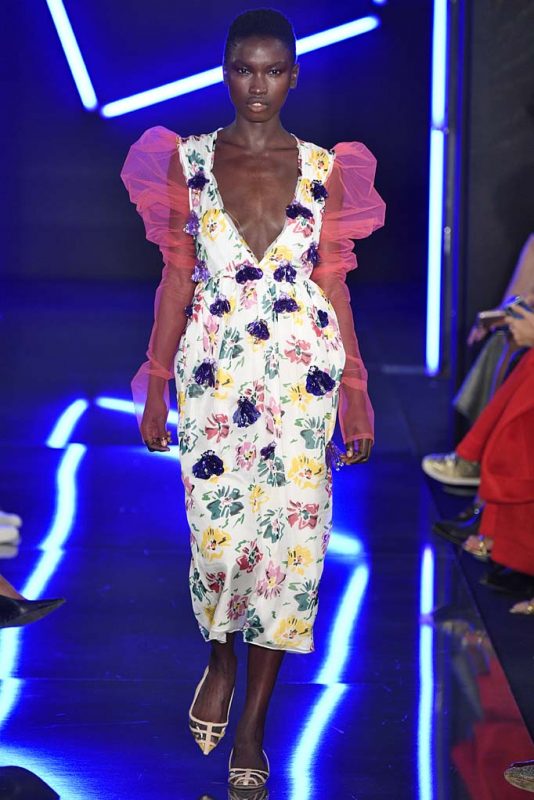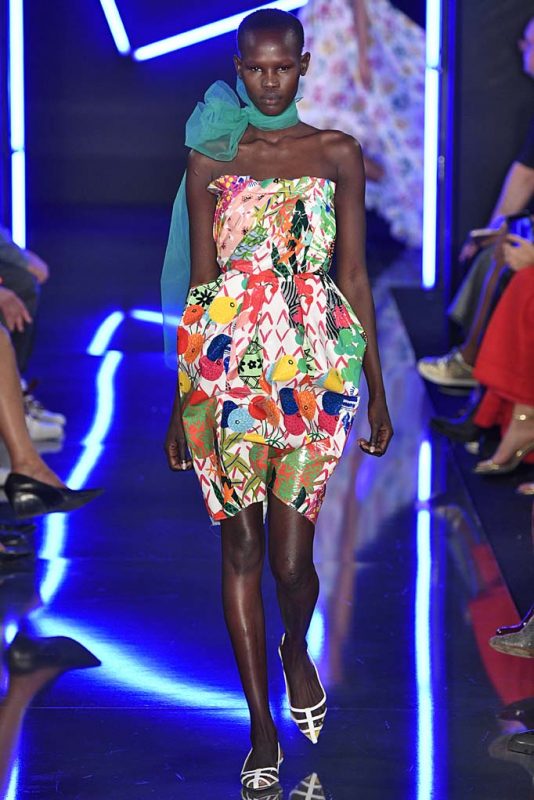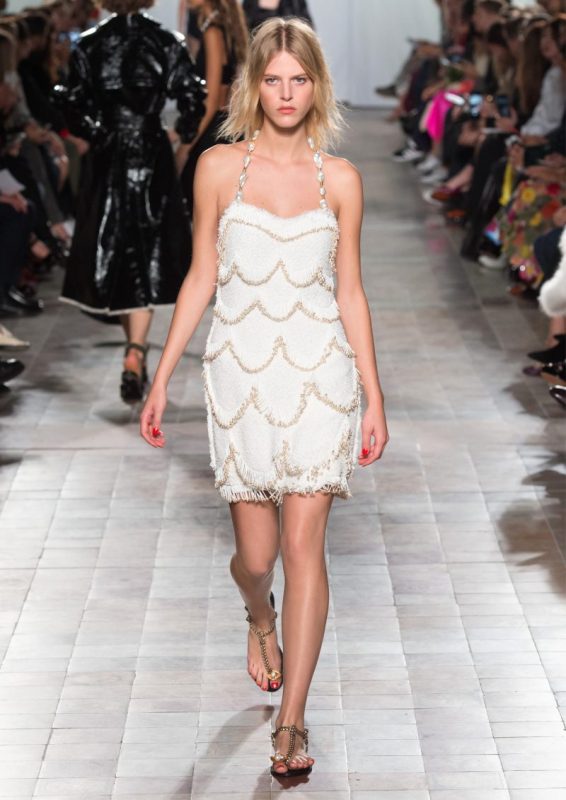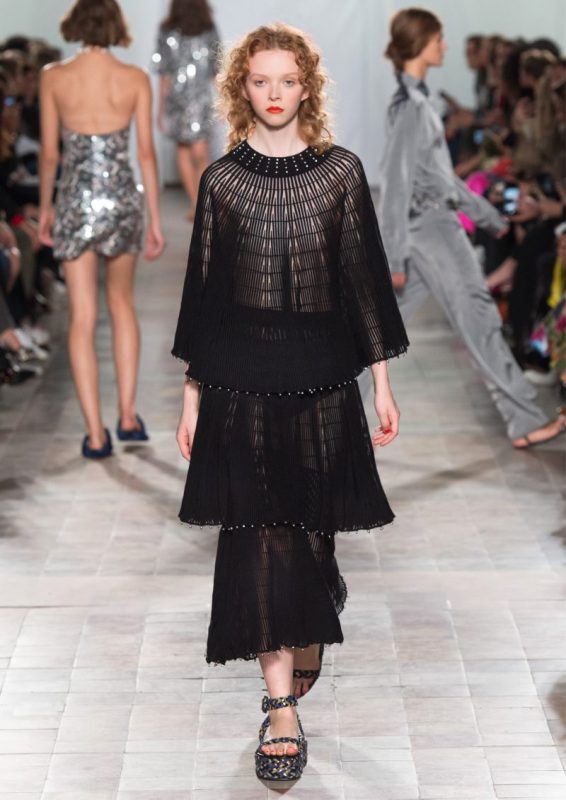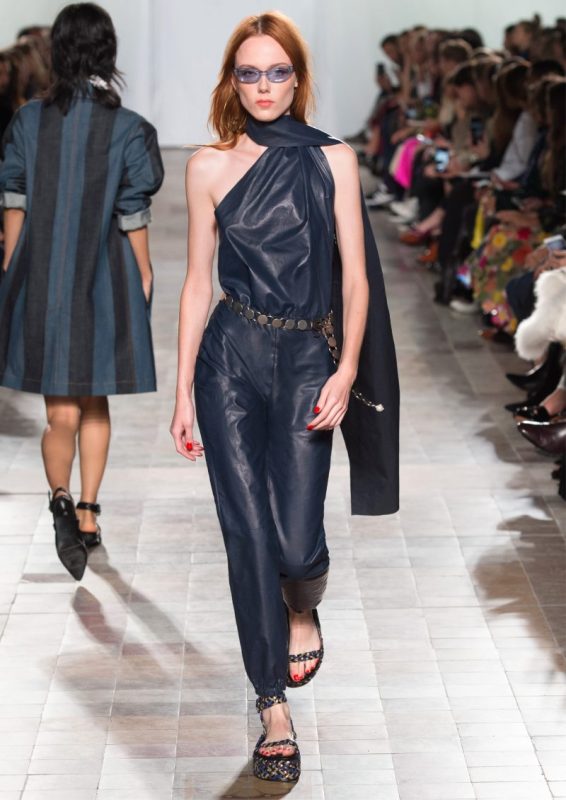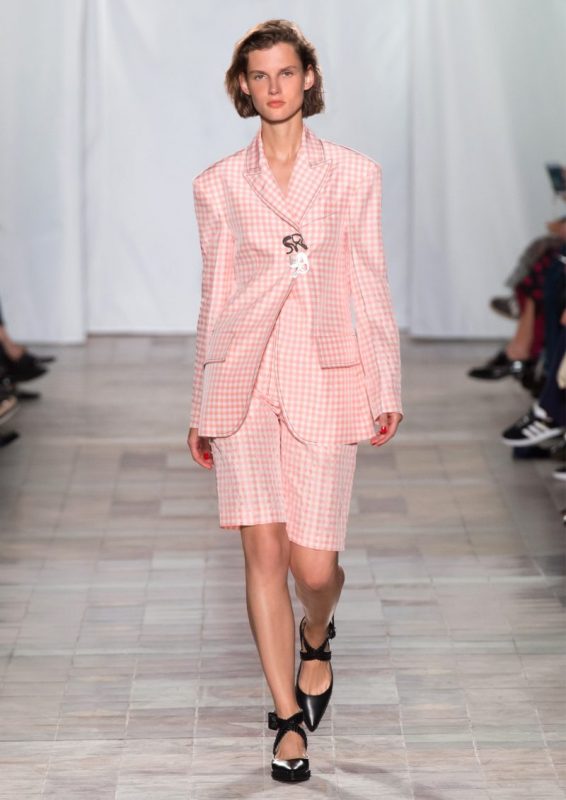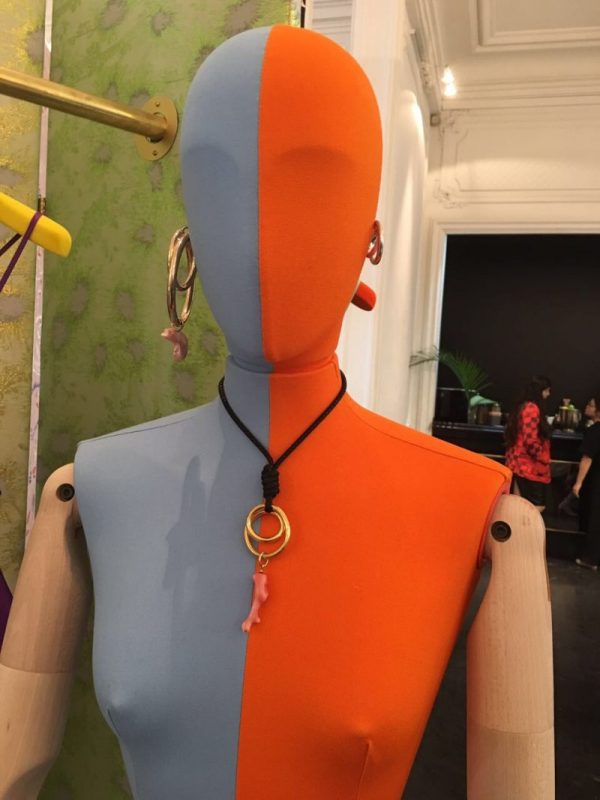Fashion editor-at-large and stylist Sofia Achaval de Montaigu takes us front row for her weekend full of fabulous fashion for her Paris Fashion Week Diary. Get an inside look at Marco Colagrossi’s debut at Emanuel Ungaro, Sonia Rykiel‘s homage to the oyster, and Issey Miyake’s performance twist on technical pleating, and other highlights.
Day 5:
Vanessa Seward
The day began at 7 a.m. for my friend and fellow Argentinian Vanessa Seward’s show. She sent me some beautiful looks to wear, which I combined with the gorgeous Elie Top jewelry. I got my hair and makeup done in a Jerry Hall fashion to match Vanessa’s style.
The location for the fashion show was at the Argentinian Embassy; I was happy to return after many years to this beautiful Maison Particulière. Bertrand Burgalat, Vanessa’s husband, was there playing the piano. He is an incredible musician and producer.
I sat beside Sabine Getty, whom I’ve known for a long time. She was wearing a fantastic velvet suit and we chatted about how much we love Catherine Deneuve, who happened to be sitting front row.
During the show, there were two girls from a Parisian collective called Catastrophe singing “Printemps, été, habillez-moi” (“Spring, Summer, dress us“) in a chanting tone that repeated itself throughout the show. The song was perfect for Vanessa’s collection—girly with a sense of humor.
The collection was inspired by the Riviera, the Saint-Tropez of Christopher Franck’s “Year of the Jellyfish,” and Righeira’s “Vamos à la playa.” There was everything from Moorish prints and Bermuda shorts to more glam lamé tops and metallic leather shorts and pants.
A set of stonewashed denim shirt and pants was a standout look, and it was combined with a denim bandana and belt. I also liked an array of short Klein-blue pants with a matching bandana and high boots and a silk dress with an overlapping plaited long skirt that ended just above the ankles with high-heel boots in baby pink. Additionally, I liked a white suit with knee-high nude boots.
I wanted to own everything! Surrounded by all of my friends and even one of my icons, this show felt like home to me.
Issey Miyake
Issey Miyake’s show was in the Salon d’Honneur in the Grand Palais and began with a spectacular performance: some figures started moving behind a silver fabric hanging in the back of the runway. Dancers appeared from behind that installation and started dancing and moving in and out of their suits, which were black and white and increasingly became more white as they twisted and moved, representing the flexibility and technical innovation of the fabrics at the house. The music was instrumental and it gave the show an aura of drama that was almost theatrical. The runway was very wide, allowing the models to walk in pairs so it looked like a dance or a play.
The prints were beautiful this season, reflecting the mountainous landscapes and colors of Iceland, where the design team visited for some inspiration ahead of creating the collection. The shoes, in black and white, were open-toed and modern, especially in the shape of the heels, and had a sporty texture.
The models’ fresh faces mirrored the crisp Icelandic landscapes in their purity, and the hairstyles went from ponytails to buns and loose, natural hair. Another achievement on this runway was the diversity of the models: different faces, ages and ethnic backgrounds—there were even twins! It was all very elegant.
Ungaro
Ungaro’s fashion show was in the Pavillon Ledoyen, and the backdrop included a black wall with blue neon lights. The lighting, combined with a slow strong music with rising percussion, created a hypnotic atmosphere. It was the first collection for the house by newly minted creative director Marco Colagrossi.
There were plenty of flower prints, transparencies, and embroidery. This last technique could be seen in two white outfits that had tone-on-tone embroideries. The shoes were almost always clear flats and worn with net socks that had rhinestones in them.
My favorite looks were a yellow gauze dress in a flower print with frilled ends and a statement making train; a matching floral shirt and pants ensemble in fuchsia and green; and a tulle white shirt that was a little see-through and had a pierrot collar, combined with a sequin white mini-skirt. The collection felt contemporary and optimistic.
- Ungaro Paris Fashion Week Spring Summer 2018 Paris September/October 2017
- Ungaro Paris Fashion Week Spring Summer 2018 Paris September/October 2017
- Ungaro Paris Fashion Week Spring Summer 2018 Paris September/October 2017
- Ungaro Paris Fashion Week Spring Summer 2018 Paris September/October 2017
- Ungaro Paris Fashion Week Spring Summer 2018 Paris September/October 2017
- Ungaro Paris Fashion Week Spring Summer 2018 Paris September/October 2017
- Ungaro Paris Fashion Week Spring Summer 2018 Paris September/October 2017
- Ungaro Paris Fashion Week Spring Summer 2018 Paris September/October 2017
- Ungaro Paris Fashion Week Spring Summer 2018 Paris September/October 2017
- Ungaro Paris Fashion Week Spring Summer 2018 Paris September/October 2017
- Ungaro Paris Fashion Week Spring Summer 2018 Paris September/October 2017
- Ungaro Paris Fashion Week Spring Summer 2018 Paris September/October 2017
- Ungaro Paris Fashion Week Spring Summer 2018 Paris September/October 2017
- Ungaro Paris Fashion Week Spring Summer 2018 Paris September/October 2017
- Ungaro Paris Fashion Week Spring Summer 2018 Paris September/October 2017
- Ungaro Paris Fashion Week Spring Summer 2018 Paris September/October 2017
- Ungaro Paris Fashion Week Spring Summer 2018 Paris September/October 2017
- Ungaro Paris Fashion Week Spring Summer 2018 Paris September/October 2017
- Ungaro Paris Fashion Week Spring Summer 2018 Paris September/October 2017
- Ungaro Paris Fashion Week Spring Summer 2018 Paris September/October 2017
- Ungaro Paris Fashion Week Spring Summer 2018 Paris September/October 2017
- Ungaro Paris Fashion Week Spring Summer 2018 Paris September/October 2017
- Ungaro Paris Fashion Week Spring Summer 2018 Paris September/October 2017
- Ungaro Paris Fashion Week Spring Summer 2018 Paris September/October 2017
- Ungaro Paris Fashion Week Spring Summer 2018 Paris September/October 2017
- Ungaro Paris Fashion Week Spring Summer 2018 Paris September/October 2017
- Ungaro Paris Fashion Week Spring Summer 2018 Paris September/October 2017
- Ungaro Paris Fashion Week Spring Summer 2018 Paris September/October 2017
- Ungaro Paris Fashion Week Spring Summer 2018 Paris September/October 2017
- Ungaro Paris Fashion Week Spring Summer 2018 Paris September/October 2017
- Ungaro Paris Fashion Week Spring Summer 2018 Paris September/October 2017
- Ungaro Paris Fashion Week Spring Summer 2018 Paris September/October 2017
- Ungaro Paris Fashion Week Spring Summer 2018 Paris September/October 2017
- Ungaro Paris Fashion Week Spring Summer 2018 Paris September/October 2017
- Ungaro Paris Fashion Week Spring Summer 2018 Paris September/October 2017
- Ungaro Paris Fashion Week Spring Summer 2018 Paris September/October 2017
- Ungaro Paris Fashion Week Spring Summer 2018 Paris September/October 2017
- Ungaro Paris Fashion Week Spring Summer 2018 Paris September/October 2017
- Ungaro Paris Fashion Week Spring Summer 2018 Paris September/October 2017
- Ungaro Paris Fashion Week Spring Summer 2018 Paris September/October 2017
- Ungaro Paris Fashion Week Spring Summer 2018 Paris September/October 2017
- Ungaro Paris Fashion Week Spring Summer 2018 Paris September/October 2017
- Ungaro Paris Fashion Week Spring Summer 2018 Paris September/October 2017
- Ungaro Paris Fashion Week Spring Summer 2018 Paris September/October 2017
Day 6:
Sonia Rykiel
Sonia Rykiel’s show was at one of the most beautiful places in Paris, the École des Beaux Arts.
The collection imagined by Julie de Libran was about empowering women and helping them pursue their passions with clothes that liberate through adaptability and functionality. The show was described in the notes as “Girls with pearls go Left Bank Paris.” De Libran was thinking about the aphrodisiac nature of the oyster and the beauty of the pearl that it creates. Those two symbols ran throughout the collection along with shells and scalloping in Rykiel’s insignia knitwear, sweaters, necklines, and shoes. Paillettes captured the iridescent nature of the oyster and the pearl. Even the bags were inspired by a “magical cotton drill box bag, inspired by days gone fishing“ in De Libran’s own words. Vichy checks appear and are revisited in the “Circle Dress“ and mixed with the brand’s classic stripes in other garments. De Libran’s idea of inverting the deep-rooted power of masculine tailoring is seen through the silk striped pyjama jumpsuit designed in work-wear fashion illustrating the ease of one-piece dressing.
Offsetting the softness of the collection were pieces like a black leather trench coat, giving the Rykiel woman another way to express her sensuality. But particularly, I liked the satin dresses because they personify femininity while being functional at the same time.
The footwear included flat sandals, high-heels, and wicker platforms. At the end of the show, silver balloons that spelled “Sonia Rykiel“ reflected the beautiful spirit of a collection that thoroughly celebrated the modern woman and her many moods.
To me, Sonia Rykiel’s fashion show was one of the best of Paris Fashion Week.
Peter Pilotto
Later today I went to see Peter Pilotto’s collection presentation and met Peter and Christopher de Vos. I talked to Peter about his inspiration to create unique designs, and he told me he finds inspiration in his friends, his trips, and in the importance and the value he bestows on the people that work for him. He told me about a member of his team that created a very technical weave based only on a drawing.
Meeting Christopher and Peter was one of the most special moments of Fashion Week—it was a quiet atmosphere allowing for an intimate conversation; they seemed charming, talented, and warm.
Peter and Christopher also told me about their curated design space in London that works as a sort of pop-up store. They were deeply involved in the project, from the aesthetics to the paintings and the furniture to bringing a new perspective and fresh look to interior design. You could see how their universe connected to their identity as artists, and they showed me how everything was related to their creations.
I loved the handbags, the tops, the jewelry, and the knitwear. The detail of the knitwear was amazing; the work in the weaving and the colors was incredible. One of my favorite looks was a sporty jacket made of silk in shades of green that was open in its elbow. It was sexy and feminine.




